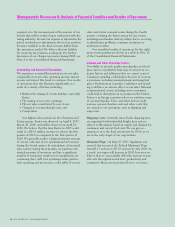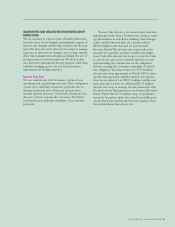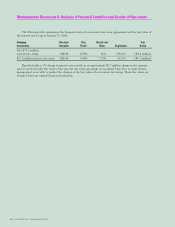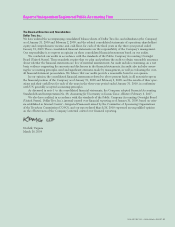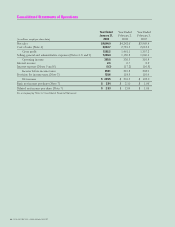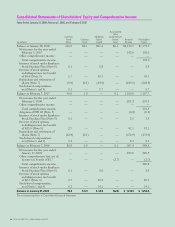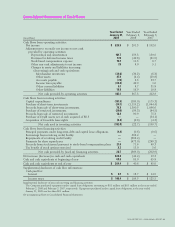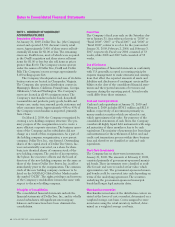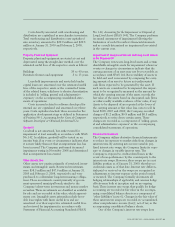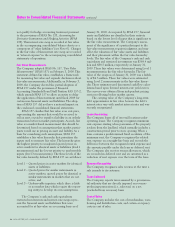Dollar Tree 2008 Annual Report Download - page 36
Download and view the complete annual report
Please find page 36 of the 2008 Dollar Tree annual report below. You can navigate through the pages in the report by either clicking on the pages listed below, or by using the keyword search tool below to find specific information within the annual report.
34
DOLLAR TREE, INC. • 2008 ANNUAL REPORT
Notes to Consolidated Financial Statements continued
not qualify for hedge accounting treatment pursuant
to the provisions of SFAS No. 133, Accounting for
Derivative Instruments and Hedging Activities (SFAS
133). This interest rate swap is recorded at fair value
in the accompanying consolidated balance sheets as a
component of “other liabilities” (see Note 6). Changes
in the fair value of this interest rate swap are recorded
as "interest expense” in the accompanying consolidated
statements of operations.
Fair Value Measurements
The Company adopted SFAS No. 157, “Fair Value
Measurements” (SFAS 157) on February 3, 2008. This
statement defines fair value, establishes a framework
for measuring fair value and expands disclosures about
fair value measurements. Additionally, on February 3,
2008, the Company elected the partial adoption of
SFAS 157 under the provisions of Financial
Accounting Standards Board Staff Position FAS 157-2,
which amends SFAS 157 to allow an entity to delay
the application of this statement until fiscal 2009 for
certain non-financial assets and liabilities. The adop-
tion of SFAS 157 did not have a material impact on
the condensed consolidated financial statements.
SFAS 157 clarifies that fair value is an exit price,
representing the amount that would be received to
sell an asset or paid to transfer a liability in an orderly
transaction between market participants. As such, fair
value is a market-based measurement that should be
determined based on assumptions that market partici-
pants would use in pricing an asset and liability. As a
basis for considering such assumptions, SFAS 157
establishes a fair value hierarchy that prioritizes the
inputs used to measure fair value. The hierarchy gives
the highest priority to unadjusted quoted prices in
active markets for identical assets or liabilities (level 1
measurement) and the lowest priority to unobservable
inputs (level 3 measurements). The three levels of the
fair value hierarchy defined by SFAS 157 are as follows:
Level 1 – Quoted prices in active markets for identical
assets or liabilities;
Level 2 – Quoted prices for similar instruments in
active markets; quoted prices for identical or
similar instruments in markets that are not
active; and
Level 3 – Unobservable inputs in which there is little
or no market data which require the report-
ing entity to develop its own assumptions.
The Company’s cash and cash equivalents,
restricted investments and interest rate swaps repre-
sent the financial assets and liabilities that were
accounted for at fair value on a recurring basis as of
January 31, 2009. As required by SFAS 157, financial
assets and liabilities are classified in their entirety
based on the lowest level of input that is significant to
the fair value measurement. The Company's assess-
ment of the significance of a particular input to the
fair value measurement requires judgment, and may
affect the valuation of fair value assets and liabilities
and their placement within the fair value hierarchy
levels. The fair value of the Company’s cash and cash
equivalents and restricted investments was $364.4 mil-
lion and $58.5 million, respectively at January 31,
2009. These fair values were determined using Level 1
measurements in the fair value hierarchy. The fair
value of the swaps as of January 31, 2009 was a liabili-
ty of $4.5 million. These fair values were estimated
using Level 2 measurements in the fair value hierar-
chy. These estimates used discounted cash flow calcu-
lations based upon forward interest-rate yield curves.
The curves were obtained from independent pricing
services reflecting broker market quotes.
The carrying value of the Company's long-term
debt approximates its fair value because the debt’s
interest rates vary with market interest rates and was
recently renegotiated.
Lease Accounting
The Company leases all of its retail locations under
operating leases. The Company recognizes minimum
rent expense starting when possession of the property
is taken from the landlord, which normally includes a
construction period prior to store opening. When a
lease contains a predetermined fixed escalation of the
minimum rent, the Company recognizes the related
rent expense on a straight-line basis and records the
difference between the recognized rental expense and
the amounts payable under the lease as deferred rent.
The Company also receives tenant allowances, which
are recorded in deferred rent and are amortized as a
reduction of rent expense over the term of the lease.
Revenue Recognition
The Company recognizes sales revenue at the time a
sale is made to its customer.
Taxes Collected
The Company reports taxes assessed by a governmen-
tal authority that are directly imposed on revenue-
producing transactions (i.e., sales tax) on a net
(excluded from revenues) basis.
Cost of Sales
The Company includes the cost of merchandise, ware-
housing and distribution costs, and certain occupancy
costs in cost of sales.


